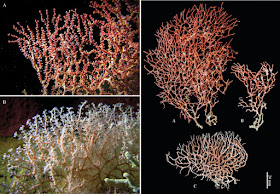 |
| Melithaea davidi
Samimi-Namin, Ofwegen & McFadden, 2016
|
Abstract
A new species, Melithaea davidi sp. n., is described from the eastern coast of Oman, Oman Sea, in the northwestern Indian Ocean, where it differs from its congeners in lacking capstans and having predominantly spindles in the coenenchyme. A molecular phylogenetic analysis of mtMutS and 28S rDNA genes suggests that it is genetically distinct from similar species in the Red Sea. Furthermore, a species previously reported as Acabaria sp. from the Arabian Sea is now identified as Melithaea mabahissi (Hickson, 1940).
Keywords: Persian Gulf, octocorals, Indian Ocean, Middle East, northwest Indian Ocean
Class Anthozoa Ehrenberg, 1831
Subclass Octocorallia Haeckel, 1866
Order Alcyonacea Lamouroux, 1812
Family Melithaeidae Gray, 1870
Subfamily Melithaeinae Alderslade, 2006
Genus Melithaea Milne Edwards, 1857
Diagnosis: Colonies with segmented axis, and swollen nodes and straight internodes containing cigar-shaped sclerites. Densely branched in one or more planes, forming large fans or forming bushes. Sclerites of coenenchymal surface are spindles, thorn-clubs, double discs, leaf clubs, and foliate spheroids. Polyps monomorphic, small and retractile. Calyces can be low or tall. Polyps contain spindle-like and club-like forms arranged as collaret and points, with dragon wing sclerites (flattened, more or less twisted, boomerang-shaped platelets commonly with the convex edge serrated near the wider end; present in the proximal part of tentacles/see Grasshoff 1999, 2000) in the tentacles. The colonies can be yellow, orange, red, dark purple, pink, and white. Axes are usually coloured, often red. Azooxanthellate.
Melithaea davidi sp. n.
http://zoobank.org/62E50344-EFEF-4F94-8007-346D0AE2A9EF
Material examined: Holotype: RMNH Coel. 42122, Oman, Oman Sea, 23.654267°N 58.629567°E, 79 m deep on a ship wreck, Robert’s barge, coll. David Mothershaw and Robin Norman, 19 July 2013. Paratypes: RMNH Coel. 42123, RMNH Coel. 42124, same data as holotype.
Description: The holotype is branching dichotomously in several parallel planes, forming a network with many anastomoses. It is 12 cm high and 9 cm wide (Figure 3). The nodes are larger and more swollen in the basal parts of the colony. Many branches are covered with tiny white ophiuroids.
......
Etymology: The species is named after David Mothershaw who collected the specimens.
Remarks:
The species resembles Melithaea biserialis (Kükenthal, 1908) and M. sinaica Grasshoff, 2000, both described from the nearby Red Sea. M. biserialis and M. sinaica both have more tuberculate sclerites and, additionally, capstans that are not present at all in M. davidi. The species also resembles Acabaria spec. indet. 2 Ofwegen (1987) from West India. However, that species also has capstans that are absent in M. davidi.
Acabaria indet. 2 Ofwegen (1987) might represent a new species, however, the material is not sufficient for describing a new species.
Acabaria mabahissi Hickson, 1940, off Cape Guardafui, Gulf of Aden, and the Arabian Sea is the same as Acabaria spec. indet. 1 (Ofwegen 1987) from Somalia and Kenya.
Discussion: Reijnen et al. (2014) observed that melithaeid species appear to be grouped phylogenetically by geographical region, suggesting high regional endemicity in this family. Our re-analysis of their mtMutS and 28S sequence data reflects this pattern, with species from the western Indo-Pacific (Indonesia, Malaysia, Japan, Palau, etc.), east and south African coasts (Tanzania, South Africa), northern and western Indian Oceans (Seychelles, Maldives), and the Red Sea separated into distinct well-supported clades (Figure 2). Therefore, the likelihood of species having wide geographical ranges is low, and consequently we did not compare the new species with similar-looking species occurring in other geographical regions. The molecular phylogenetic analysis suggests that M. davidi is closely related to but distinct from several other species found in the Red Sea region for which we had sequence data for comparison. Although we did not have sequence data for Melithaea biserialis or Acabaria spec. indet. 2 reported by Ofwegen (1987), morphological differences support the distinction of those species from M. davidi.
Kaveh Samimi-Namin, Leen P. van Ofwegen and Catherine S. McFadden. 2016. A New Species of Melithaea (Anthozoa, Octocorallia, Melithaeidae) from the Oman Sea, off Oman.
ZooKeys. 623; 15-29. DOI: 10.3897/zookeys.623.10045
ZooKeys. 623; 15-29. DOI: 10.3897/zookeys.623.10045




